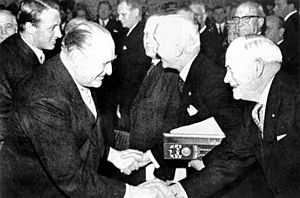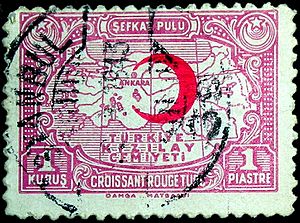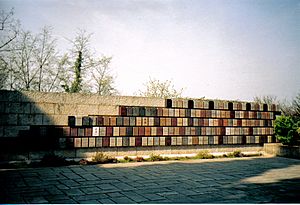International Federation of Red Cross and Red Crescent Societies facts for kids

Emblem of the IFRC
|
|
| Abbreviation | IFRC |
|---|---|
| Formation | 5 May 1919 |
| Type | Humanitarian aid organization |
| Purpose | To carry out relief operations to assist victims of disasters, and combine this with development work to strengthen the capacities of its member National Societies |
| Headquarters | Geneva, Switzerland |
|
Secretary General
|
Jagan Chapagain |
|
President
|
Kate Forbes |
|
Main organ
|
Governing board |
|
Parent organization
|
International Red Cross and Red Crescent Movement |
|
Budget
|
495,444,000 CHF |
|
Employees (2022)
|
2,500 |
| Website | www.ifrc.org |
The International Federation of Red Cross and Red Crescent Societies (IFRC) is a global group that helps people in need. It is a huge humanitarian aid organization that helps about 160 million people every year. It does this through its 191 member groups, called National Societies, which are found in countries all over the world.
The IFRC helps people before, during, and after disasters like earthquakes or floods. It also helps during health crises. The goal is to improve the lives of people who are struggling. The IFRC helps everyone, no matter their nationality, race, gender, religion, or political beliefs.
The IFRC is part of a larger group called the International Red Cross and Red Crescent Movement. This movement also includes the International Committee of the Red Cross (ICRC) and the 191 National Societies. The IFRC's main strength is its huge network of volunteers and its expert knowledge of local communities.
Contents
History of the IFRC
How the Federation Started
After World War I, on May 5, 1919, five countries came together in Paris, France. These were the United Kingdom, France, Italy, Japan, and the United States. They created the League of Red Cross Societies. Their goal was to unite Red Cross groups to improve health and help create new groups.
The idea came from Henry P. Davison of the American Red Cross. He wanted the Red Cross to do more than just help in wars. He thought it should also help people during natural disasters and health emergencies. The new League also helped National Societies get started and grow, especially during times of peace.
At first, the ICRC was worried about this new group. They thought the League might try to take over its leadership role. But in 1928, the two groups agreed on how to work together. They decided on the roles each would play to avoid problems.
Growing Around the World
The League quickly grew. By 1920, it had 27 member societies. Over the next ten years, more than 25 new groups joined. These included the Egyptian Red Crescent and the Red Lion and Sun of Iran. By the mid-1930s, the League had 58 National Societies and was truly a worldwide organization.
The League's main office, or secretariat, was first in Geneva, Switzerland. In 1922, it moved to Paris to create its own identity, separate from the ICRC. But in 1939, when World War II was starting, the office moved back to Geneva because Switzerland was a neutral country. The headquarters has been in Geneva ever since.
Early Missions and Helping People
One of the League's first missions was to study a typhus sickness in Poland. It shared information with nearby countries to stop the disease from spreading. The first major relief effort was after a huge earthquake in Japan in 1923. The earthquake killed about 200,000 people. For the first time, 35 National Societies worked together with the ICRC and the League to help.
During the 1930s, more people started driving cars, which led to more accidents. The League became a leader in teaching first aid for road accidents.
When World War II began, the League worked closely with the ICRC. They helped civilians affected by the war by sending food and medical supplies. After the war, the League helped rebuild and provide relief to areas that had been damaged.
Changes and a Nobel Peace Prize

As more countries became independent in the 1950s and 1960s, the number of Red Cross and Red Crescent societies grew. By the end of the 1960s, there were over 100 societies. In 1963, the League and the ICRC were jointly awarded the Nobel Peace Prize for their amazing work.
In 1983, the organization changed its name to the "League of Red Cross and Red Crescent Societies." This was to include the many societies that use the Red Crescent symbol. In 1991, it changed its name again to what it is today: the International Federation of Red Cross and Red Crescent Societies (IFRC).
In 2004, the IFRC led its biggest mission ever after a tsunami in South Asia. Over 40 National Societies and 22,000 volunteers helped the millions of people who lost their homes and were in danger.
What the IFRC Does Today
The IFRC coordinates the work of National Red Cross and Red Crescent Societies all over the world. It helps start new societies in countries that don't have one. When a disaster happens, the IFRC works with the local National Society and other societies that want to help.
The main tasks of the IFRC are:
- To promote humanitarian values, like kindness and helping others.
- To support its 191 National Societies.
- To support projects that help people in need.
The Red Cross and Red Crescent is the world's largest humanitarian network. It has:
- Nearly 11.6 million volunteers.
- Over 473,000 paid staff members.
- More than 165,000 local branches.
- Over 11 million people trained in First Aid each year.
How the IFRC is Organized
The IFRC's main office is in Geneva, Switzerland. It also has regional offices around the world to manage its work. The IFRC is led by a president and a governing board. The board includes representatives from 20 National Societies.
The current president of the IFRC is Kate Forbes from the American Red Cross.
The IFRC gets its money from several places. National Societies pay annual fees. The IFRC also receives money from governments, companies, and people who want to support its work. For big emergencies, the IFRC asks for special donations through emergency appeals.
Symbols and Beliefs
The emblem of the IFRC combines the red cross and the red crescent symbols side-by-side. The IFRC's motto is "Per Humanitatem ad Pacem," which is Latin for "Through Humanity to Peace."
The work of the IFRC is guided by seven Fundamental Principles:
- Humanity: To help people who are suffering.
- Impartiality: To help everyone without discrimination.
- Neutrality: To not take sides in conflicts.
- Independence: To remain separate from governments.
- Voluntary Service: To help others without wanting payment.
- Unity: To have only one Red Cross or Red Crescent society in each country.
- Universality: To be a worldwide movement where all societies are equal.
Working with the ICRC
The IFRC and the ICRC are partners in the same movement, but they have different jobs. In 1997, they signed the Seville Agreement to make their roles clear.
The ICRC takes the lead in situations of armed conflict or war. The IFRC takes the lead in all other emergencies, like natural disasters. This agreement helps them work together smoothly to help as many people as possible.
See also
 In Spanish: Federación Internacional de Sociedades de la Cruz Roja y de la Media Luna Roja para niños
In Spanish: Federación Internacional de Sociedades de la Cruz Roja y de la Media Luna Roja para niños




